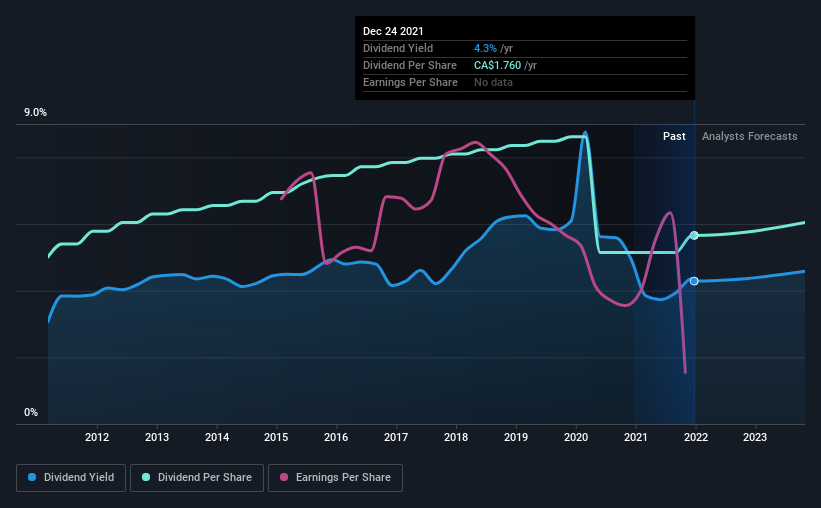Here's Why We're Wary Of Buying Laurentian Bank of Canada's (TSE:LB) For Its Upcoming Dividend
Laurentian Bank of Canada (TSE:LB) is about to trade ex-dividend in the next four days. Typically, the ex-dividend date is one business day before the record date which is the date on which a company determines the shareholders eligible to receive a dividend. The ex-dividend date is an important date to be aware of as any purchase of the stock made on or after this date might mean a late settlement that doesn't show on the record date. In other words, investors can purchase Laurentian Bank of Canada's shares before the 30th of December in order to be eligible for the dividend, which will be paid on the 1st of February.
The company's next dividend payment will be CA$0.44 per share. Last year, in total, the company distributed CA$1.76 to shareholders. Looking at the last 12 months of distributions, Laurentian Bank of Canada has a trailing yield of approximately 4.3% on its current stock price of CA$41.05. Dividends are a major contributor to investment returns for long term holders, but only if the dividend continues to be paid. So we need to investigate whether Laurentian Bank of Canada can afford its dividend, and if the dividend could grow.
See our latest analysis for Laurentian Bank of Canada
Dividends are usually paid out of company profits, so if a company pays out more than it earned then its dividend is usually at greater risk of being cut. Laurentian Bank of Canada paid out 155% of profit in the past year, which we think is typically not sustainable unless there are mitigating characteristics such as unusually strong cash flow or a large cash balance.
Generally, the higher a company's payout ratio, the more the dividend is at risk of being reduced.
Click here to see the company's payout ratio, plus analyst estimates of its future dividends.
Have Earnings And Dividends Been Growing?
Companies with falling earnings are riskier for dividend shareholders. If earnings decline and the company is forced to cut its dividend, investors could watch the value of their investment go up in smoke. With that in mind, we're discomforted by Laurentian Bank of Canada's 26% per annum decline in earnings in the past five years. Ultimately, when earnings per share decline, the size of the pie from which dividends can be paid, shrinks.
Laurentian Bank of Canada also issued more than 5% of its market cap in new stock during the past year, which we feel is likely to hurt its dividend prospects in the long run. Trying to grow the dividend while issuing large amounts of new shares reminds us of the ancient Greek tale of Sisyphus - perpetually pushing a boulder uphill.
Another key way to measure a company's dividend prospects is by measuring its historical rate of dividend growth. Laurentian Bank of Canada has delivered an average of 1.2% per year annual increase in its dividend, based on the past 10 years of dividend payments.
Final Takeaway
Has Laurentian Bank of Canada got what it takes to maintain its dividend payments? Not only are earnings per share shrinking, but Laurentian Bank of Canada is paying out a disconcertingly high percentage of its profit as dividends. Generally we think dividend investors should avoid businesses in this situation, as high payout ratios and declining earnings can lead to the dividend being cut. These characteristics don't generally lead to outstanding dividend performance, and investors may not be happy with the results of owning this stock for its dividend.
With that being said, if you're still considering Laurentian Bank of Canada as an investment, you'll find it beneficial to know what risks this stock is facing. Every company has risks, and we've spotted 3 warning signs for Laurentian Bank of Canada you should know about.
A common investment mistake is buying the first interesting stock you see. Here you can find a list of promising dividend stocks with a greater than 2% yield and an upcoming dividend.
Have feedback on this article? Concerned about the content? Get in touch with us directly. Alternatively, email editorial-team (at) simplywallst.com.
This article by Simply Wall St is general in nature. We provide commentary based on historical data and analyst forecasts only using an unbiased methodology and our articles are not intended to be financial advice. It does not constitute a recommendation to buy or sell any stock, and does not take account of your objectives, or your financial situation. We aim to bring you long-term focused analysis driven by fundamental data. Note that our analysis may not factor in the latest price-sensitive company announcements or qualitative material. Simply Wall St has no position in any stocks mentioned.

 Yahoo Finance
Yahoo Finance 
